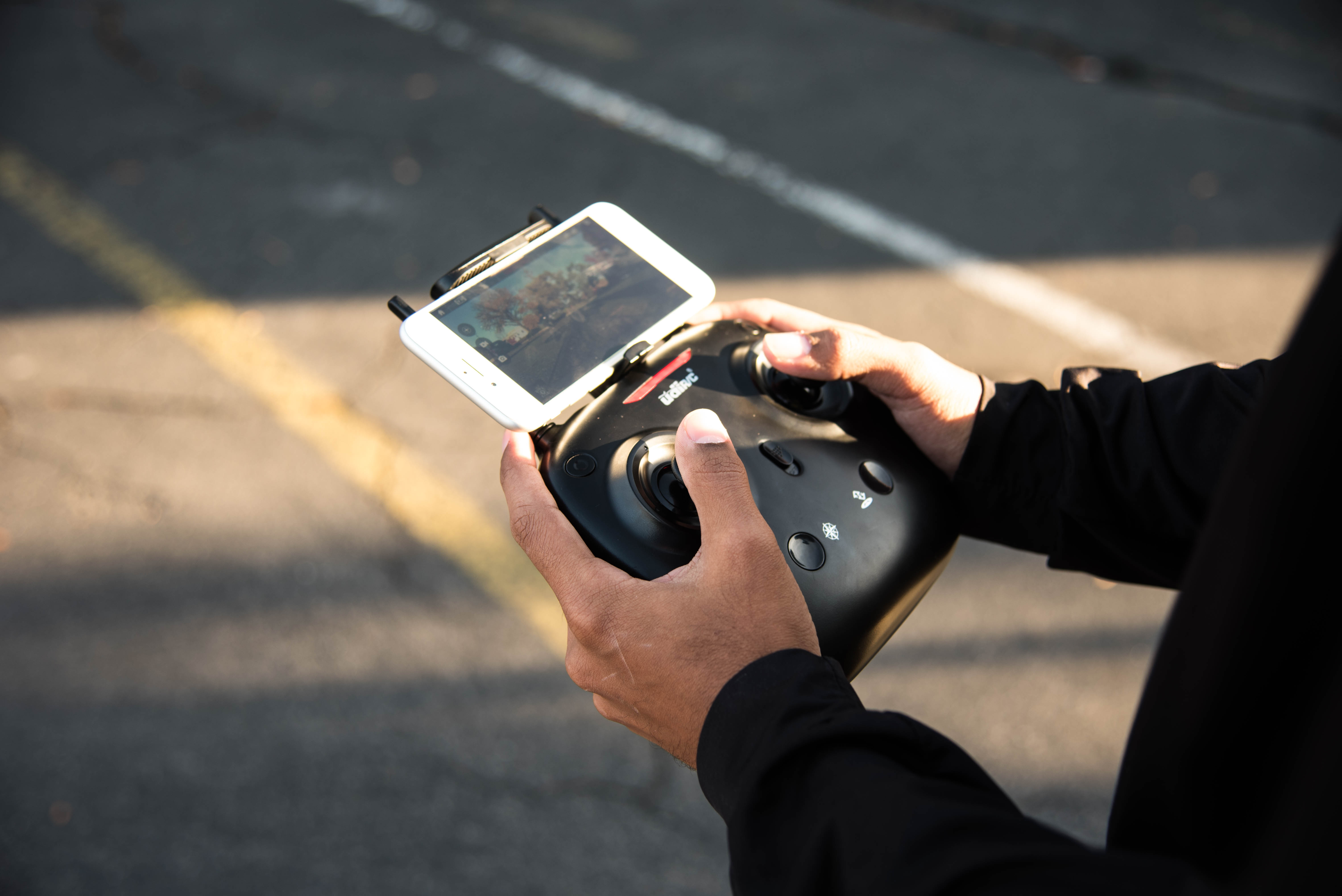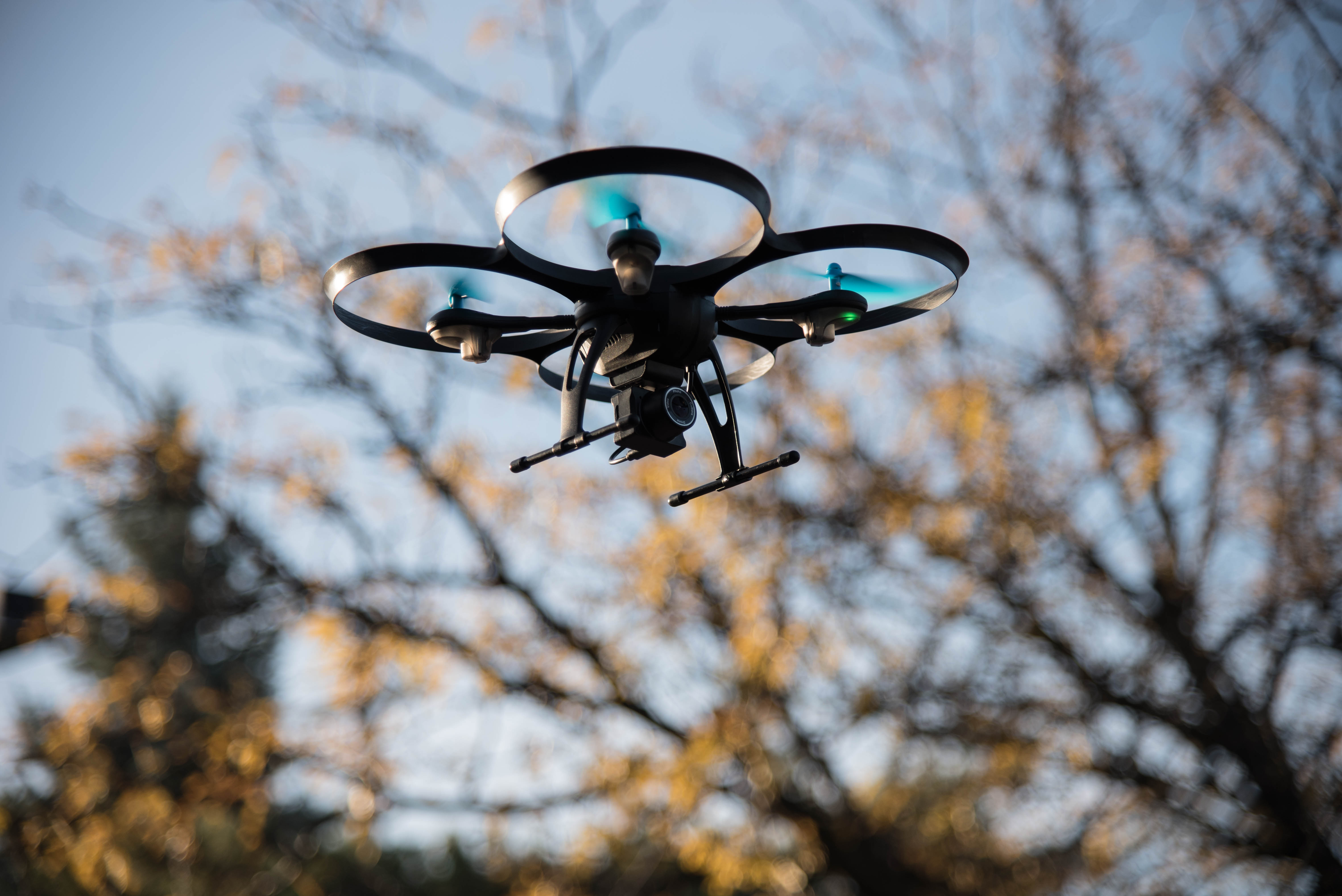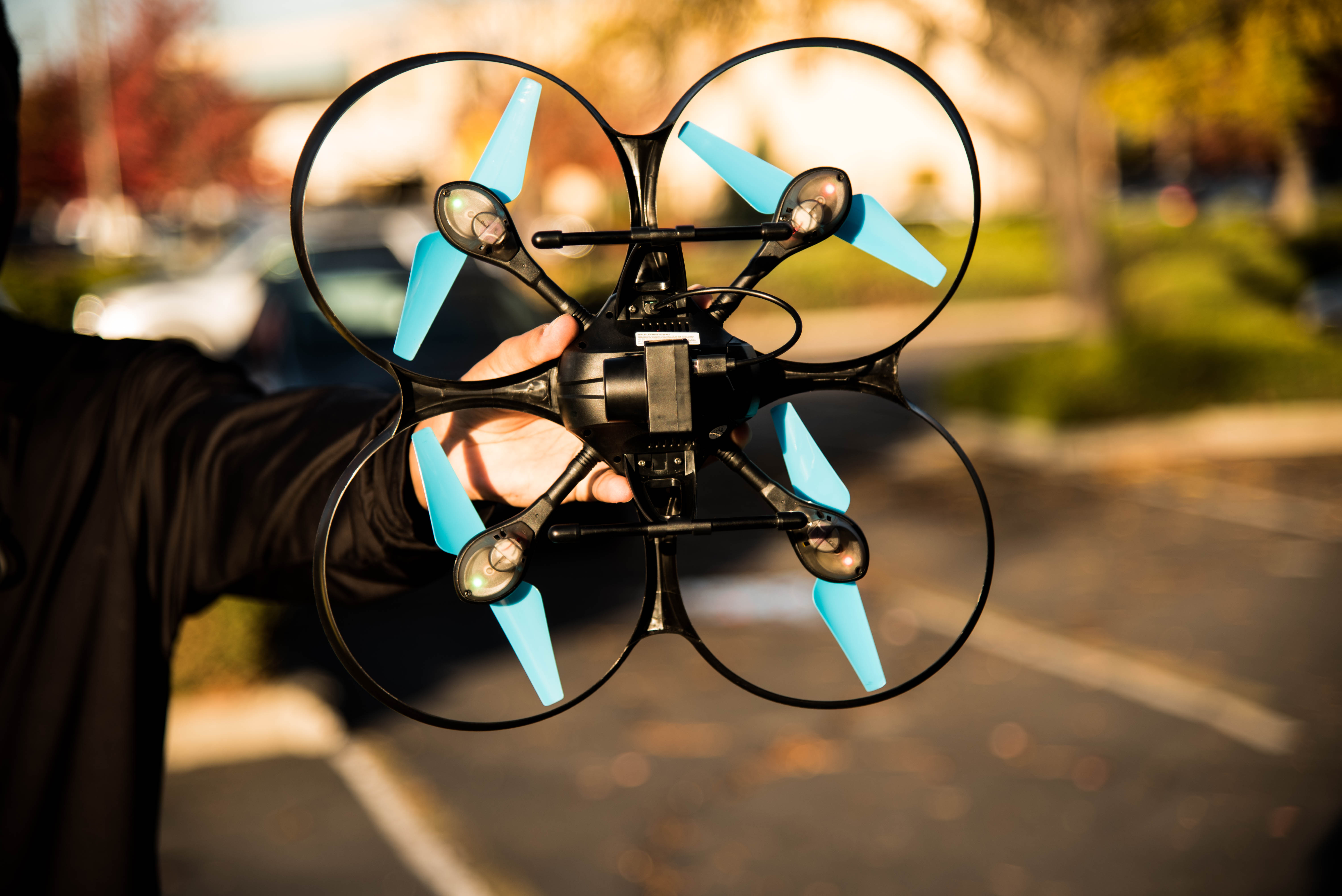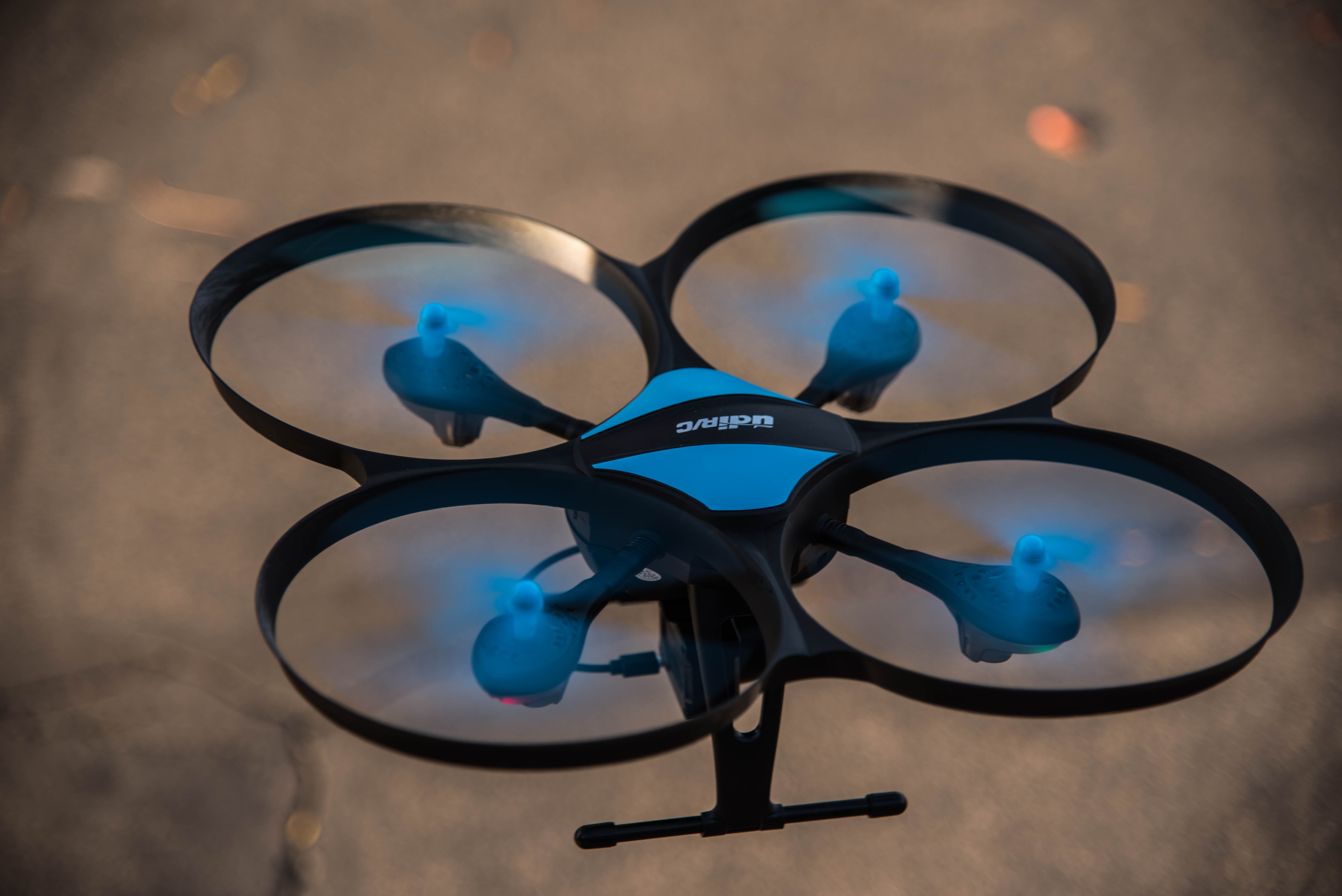 The next drone we were able to get our hands on is the Force1 Blue Heron (also called the U49W). This drone fits neatly into our intermediate difficulty of drones for a number of reasons, not the least of which its versatility as a toy and photography aircraft.
The next drone we were able to get our hands on is the Force1 Blue Heron (also called the U49W). This drone fits neatly into our intermediate difficulty of drones for a number of reasons, not the least of which its versatility as a toy and photography aircraft.
We envision the Blue Heron being utilized for a number of activities besides professional photography. It really is a versatile aircraft for a modest price and number of spare parts that come with it.
Setting Up
When you first get the Blue Heron, it’ll come with four extra propellers and tops for said propellers. It also comes with an extra battery. Extra parts at no extra cost are a huge plus in our opinion, especially with batteries.
You’ll have to screw in the landing gear using a small screwdriver that also comes with the package. These screws were extremely difficult to get in all the way, so we left a couple of them not in all the way. If they don’t fit in all the way, don’t worry about it. The first couple times our Blue Heron went up in the air it had some run-ins with walls and the landing gear didn’t even move.
This brings us to another point-landing gear. It’s so worth the overall price of the Blue Heron. Almost every drone above the Blue Heron will have landing gear. They’re worthwhile investments so you should obviously do what you can to protect them.
Systems
If you’re a little unsure of how to lift off or land the Blue Heron, worry not. Both the app and the controller have a simple button that will start the propellers and land the aircraft wherever it is. Don’t try and mash the button if the drone doesn’t immediately start to land. All you need is a firm press or two and the Blue Heron will respond in kind.
Trim-This function is a little tricky to understand. Trim is defined as the rate at which your drone moves to the left or right. Too much trim will cause the Blue Heron to almost dip when it moves. Trimming is useful if want the drone to move a little faster or rotate the body in a certain direction.
- In regards to the Blue Heron, the trim function really works. This drone does a great job of allowing you to customize the drone’s speed and maneuverability.
Headless Mode-When you first set up the drone, whichever way the camera is facing is the way the drone will identify as forward. To turn off and off this function, press the button with the compass next to it. This activates headless mode, which tells the drone that any way is forwards depending on how you trim the drone. It will also switch up the orientation of the controls, as you’ll find out, so be prepared!
- Like the take-off/landing button, try not to mash it if you don’t think its working. This function is especially helpful for new pilots as they adjust to a drone’s sensitivity.
Camera
The maximum frame rate on the Blue Heron’s camera is 720P, with a 120-degree angle optic. 720P isn’t the much sought after 1080P resolution but maybe you bought the Blue Heron because professional photography wasn’t exactly in mind. For the price, the 720P is the perfect type of camera for an amateur or intermediate pilot looking to expand his or her skills with this type of camera drone.
To operate the camera, you’ll need to download the Flyingsee app on a smartphone or tablet. Once connected, you’ll be able to see what the drone sees even if you’re not directly looking at it. The great thing about the Blue Heron’s camera is that it broadcasts in real time without even a hint of lag. It does this through its own personal WiFi connection that you’ll have to connect to in order to operate it.
- Interested pilots will be happy to note the speed of the Blue Heron’s camera. Lagging is never fun and more often than naught leads to crashes.
If you have a smartphone, we recommend placing it in the controller’s holder to be more efficient with piloting and photography. In order to take videos, you’ll have to use a mini SD card that fits into the side of the camera. Photos are immediately transferred to both the Flyingsee app and your smart device’s photo storage if you allow the app to do so.
Capabilities
In an enclosed environment, the Blue Heron is a great drone to fly around with powerful lifting and trimming capabilities. If you let it fly above you, you’ll get a whiff of just how powerful these propellers are. With landing gear, you can try your hand at landing on tricky surfaces and playing around with the trimming ability. Mastering maneuverability isn’t going to happen in a day, but that’s why you’ve got a combined time of nearly half an hour of flight time between two batteries.
Just because propellers are powerful doesn’t mean you should take it out flying in high wind environments. Despite its medium size, the Blue Heron is a very light drone and high winds will make short work of it, so take care of it!
Flying the Blue Heron
We can’t thank Force1 enough for sticking air guards around the propellers. This drone is by no means invincible and the air guards really help keep in the air for that full 15-minute battery life. You might brush up against the walls of an enclosed space but its better than having the actual propellers hitting the walls. With extra propellers, you can rest assured you won’t have to spend money on additional parts right off the bat.
We have to admit, we had a couple of crashes with the Blue Heron when we first started out, but that’s before we realized how sensitive the controls are. Because of this, we recommend using the remote control first before moving onto the smart device app controls.
The remote control is an easy way for beginners to get to know more advanced drones and play around with the trimming feature. As we mentioned, the Blue Heron is sensitive to commands and doesn’t always stay in one spot even if you’re not touching the controls.
- For beginners: we recommend having one person flying the drone and another handling the camera on the app.
Another neat thing about drone is that the underside of each propeller is equipped with red or green lights. These lights not only aid in nighttime flying but will tell you when the drone is paired with the remote control.
Overall
The Blue Heron was an awesome drone to fly and the quintessential intermediate drone. It’s got the maneuverability of beginner and mini drones while adding some of the complexity that comes with more advanced drones with camera and video capabilities.
Sure, the camera isn’t the type you’ll find on a professional photographer’s drone, but it gets the job done and picture quality isn’t bad if you can get up close with the drone itself. With a couple of abilities to make your flight more enjoyable, the Blue Heron is the drone for anyone from the beginner to the amateur.



Social Menu